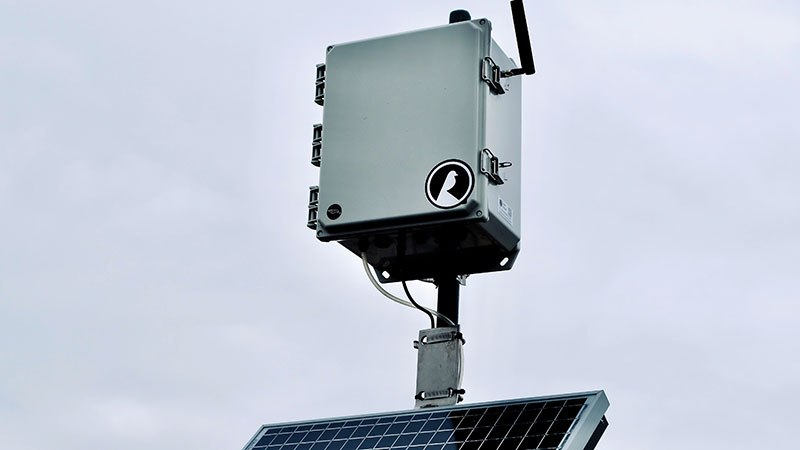January 2022, Vol. 249, No. 1
Features
Canary Project Explores “Responsibly Sourced Gas” Possibilities
By Richard Nemec, Contributing Editor
In October, privately held, Denver-based PureWest Energy LLC took bids on 7% of its Wyoming natural gas output that was certified as coming from net-zero wells that are also certified as being responsibly sourced. The gas was offered for winter or one-year delivery starting in November 2021.

PureWest was testing the market. Its gas comes from southwest Wyoming and is delivered via pipelines primarily to utilities and other wholesale gas buyers in the Pacific Northwest and Southern California. If the offer attracted buyers, it would be the first known sale of “responsibly sourced gas” (RSG) in the United States that’s third-party verified from production to delivery, the company said.
PureWest is a poster child for Denver-based Project Canary, an environmental monitoring service that is gaining recognition throughout major U.S. oil and gas basins.
Canary has verified very low carbon-dioxide emissions from two PureWest well pads, allowing the E&P that formerly operated as Ultra Petroleum to buy carbon offsets covering 12,000 tons of carbon dioxide (CO2) emissions by the company and its vendor. As a result, PureWest can claim its 90-well output as having net-zero carbon impact.
PureWest and other operators that have had their supplies certified by the Canary Project are seeking to show that some buyers are looking to purchase RSG supplies and will pay a premium, justifying the extra effort by oil and gas companies to certify their production as net-zero carbon, according to Project Canary officials.
Canary deploys a continuous environmental monitoring system assessing emissions in real time, covering methane emissions, volatile organic compounds (VOC) levels, ozone issues, or fugitive emissions. It uses artificial intelligence (AI) in deploying what it calls “rugged, all-weather sensors” that are located at the corners of well sites and transmit data to the Canary ESG Platform every minute.
It features an X model of monitoring that is the next generation of continuous monitoring technology; a S model as a continuous solar powered air quality and meteorological monitoring system designed to provide size, reliability and flexibility; and a cannister add-on allowing the addition of an auto-triggered summa canister that offers the ability to obtain high quality samples and receive “lab-grade analysis and speciated (evolved) VOC at parts-per-billion (PPB) levels.”
“What Project Canary is about is that we stop the way we are putting methane and CO2 emissions into the air and heating up the planet,” said Chris Romer, CEO and co-founder of the organization.
Romer and Canary’s chief scientist Anna Scott emphasize that they deploy “rigorous” engineering monitoring processes. “It starts at the wellhead level, and then we track and follow those products along the supply chain as they get transported via pipeline, and they arrive at various end uses,” Scott said.
Canary approaches emissions the way public accounting firms approach financial audits. Estimates won’t do the job, so continuous monitoring is deployed to give a real accounting of how much CO2 and methane is escaping into the atmosphere, said Canary’s COO and co-founder Will Foiles. “There is a tremendous amount of variability with every piece of equipment [deployed in the oilfield and pipeline space],” he said. “There are billions of dollars of financial risk, so estimates won’t cut it.”
Instead, engineers review thousands of pages of documentation, including operating records, safety protocols and continuous monitoring data, while Canary officials boast that their data is trusted and verifiable.
A supplier of natural gas will have monitors on all of its wellheads supplying RSG, according to Jason Oates, a vice president with Denver-Julesburg Basin E&P Crestone Peak Resources LLC, Oats characterizes the use of continuous monitoring as a “game changer” for his company. “It gives us the data that we need to know that our operations are safe and we’re not harming the environment.”
Canary services involve a full lifecycle program spanning well-construction through reclamation planning. It uses the proprietary TrustWell certification process that is characterized as being rooted in engineering principles and focused on engineering controls aimed at lessening the effects of operations on air, water, land, and community.
Each tracking job is unique and should address the governing standards established by the company/client pertaining to all wells. Ultimately, a plan needs to be developed specific to the region of operation and the involved well pads.
An official with the Marcellus Shale Coalition (MSC) underscored how AI and service firms like Canary are making continuous methane monitoring sensors and responsibly sourced gas certification more common in the oil and gas patch.
“It is a highly digital process that applies to upstream and midstream – and this RSG trend is growing rapidly,” said MSC spokesperson John Sutter.





Comments